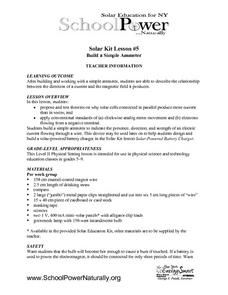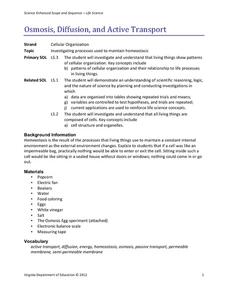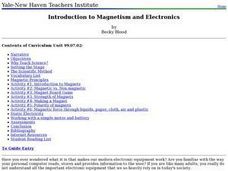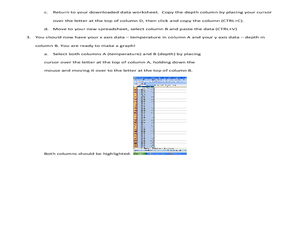Curated OER
Insulators And Conductors
High schoolers investigate the flow of electricity and how it effects different objects in the classroom as being classified as an insulator or conductor. They work in teams to test the conductivity of different classroom objects after...
Curated OER
Magnets 1: Magnetic Pick-ups
Students are introduced to the power of magnets. In groups, they look at different objects and make predictions on whether they believe they are magnetic or not. They test their predictions and share their results with the class.
Curated OER
Magnets 2: How Strong is Your Magnet?
Students work together to test the strengths of various types of magnets. After testing, they create a graph showing how the strength changes as the distance from the magnet increases. They discuss how forces can act from various...
Curated OER
Build a Simple Ammeter
Students build and work with a simple ammeter to test theories on why solar cells connected in parallel produce more current that in series. Students use the ammeter to indicate the presence, direction, and strength of an electric...
Curated OER
Conductivity
Young scholars work together to create a simple conductivity tester. They discover the difference between conductors and insulators. They test different types of materials for their conductivity as well.
Curated OER
Series and Parallel Circuits
Students study simple circuits. After a demonstration of parallel and serial circuit designs, students work in teams to predict the difference between two circuit designs. They build examples of two different circuits and test...
Curated OER
Magnets, Electromagnets, and Motors
Learners investigate the concepts of magnetism and its properties. They construct a magnet and test foods for iron content. Then students define the use of a motor and make their own electric motor while working in small groups. Then...
Curated OER
What is Energy?
Learners define energy and identify the different types that exist. They identify places they see, hear or feel energy. They understand the role of engineering in finding and testing sources of energy for the production of electricity.
Curated OER
Making A Compass
This interesting science instructional activity is about the compass. Students make a compass out of a magnet, sewing needle, cork, and a glass dish. The instructional activity includes both a pre and post-test for the students to take,...
Curated OER
Please Turn Up the Lights!
Eighth graders discuss series and parallel circuits and design an investigation to test a hypothesis on total resistance of series and parallel circuits in combination. After discussion, groups design their experiments, run tests, and...
Curated OER
The Ghost Particle
Students collect evidence to make inferences about a object hidden inside a sealed box. They think critically and logically to raise questions. Students identify questions that can be answered through investigation. They formulate and...
Curated OER
Making an Electromagnet
Young scholars explore electromagnetic forces. In this electromagnetic activity, students construct a working electromagnet and conduct a series of experiments to see what increases the strength of an electromagnet.
Virginia Department of Education
Osmosis, Diffusion, and Active Transport
No, it really is okay to play with your food! Emerging scientists manipulate popcorn, eggs, and other household objects as they demonstrate multiple cellular processes. The activity, capable of modifications, is designed to reflect the...
Curated OER
Making a Battery
Fifth graders make a battery. In this physical science lesson, 5th graders word in pairs make the battery. Students follow 4 steps to create the battery.
Cornell University
Making a Battery
Don't be shocked when your class has a blast making their own batteries! Science scholars examine a dry cell battery, then design and construct a wet cell battery. The activity guides them through the parts of a battery, the variables...
Curated OER
Fuel Cell Experimentation
With rising oil prices and increasing concerns over global warming, the pressure is on for engineers to develop alternative sources of energy. Among the new technologies being developed are hydrogen fuel cells, which young scientists...
Curated OER
Top Quark Lab
Young scholars find the mass of the top quark. In this physics lesson, students create a vector diagram from a given set of data. They discuss their calculations and findings in class.
Curated OER
Magnetic Pick-ups
Students gain an understanding that certain materials are attracted to magnets and some are not.
Curated OER
Insulators and Conductors
Fourth graders experiment to discover which items are conductors and which items are insulators. In this insulators and conductors instructional activity, 4th graders experiment and create a T-Chart. Students are assessed on the...
Curated OER
Renewable Energy in Connecticut - Softening Our Footprint through Sustainable Energy Use
High schoolers explore energy conservation. In this environmental lesson plan, students will look at data showing the amounts of energy used, our carbon footprint, and will research a power source. This unit allows for a deeper...
Curated OER
Introduction to Magnetism and Electronics
Students are introduced to the concepts of magnetism and electronics. As a class, they walk through the steps of the scientific method and define new vocabulary. In groups, they are given a bag of objects and they are to separate them...
Curated OER
Build a Simple Motor?
Students experience how to construct a simple electromagnet based motor. In groups they explore what a component is and construct a circuit that can rotate the orientation of the magnet by turning the switch on and off. Electromagnetic...
Curated OER
What's A Water Column Profile?
Learners investigate water column data. In this earth science and seawater instructional activity, students determine how temperature, salinity, and density have an impact on sea water by viewing and analyzing data obtained from a number...
Curated OER
Magnetic Discovery Bottle
Students examine how to conduct simple investigations and use simple equipment to gather data. In this magnet lesson students decide what types of objects are attracted to magnets.

























